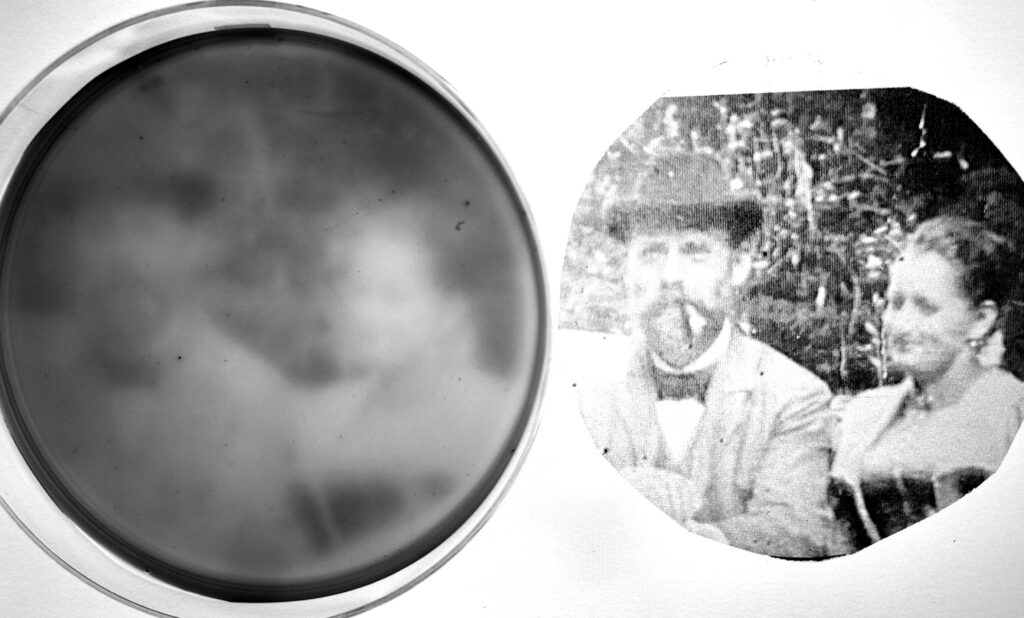“History is written by the victors.” Or so the saying goes.
I personally prefer, “The truth shall set you free”.
The true story behind Robert Koch’s discovery of bacteria brings this truth to light. For over a century, we have attributed the culturing of bacteria to Robert Koch, who eventually coined his famous postulates. Those postulates became the cornerstone of microbiology research, spurring the development of myriad antibiotics to treat infectious diseases. Yet the truth is, his culturing method was refined by a rarely remembered woman: Fanny Angelina Hesse (1850-1934). It was she who came up with the idea to grow bacteria in a special kind of jelly called agar.
I had never heard of her world-changing breakthrough, having always assumed that Koch was the first to use agar. That was until Corrado Nai posted about his Kickstarter project. He has brought together a team of skilled visual artists, science writers, and scientists to create a graphic novel to tell this story. Once it gets funded, they hope to complete the story and publish it in the summer of 2025. Upon hearing the amazing tale, I pitched into the project. Now, I have the delight of interviewing him about it.
Read on if you want to hear more about the tale and his plans to deposit newly emerged historical materials at the Museum of the Robert Koch Institute! You can also pitch into the Kickstarter campaign by clicking on the banner below. And with that, I hope you enjoy!
The interview
PN: Congratulations on your journey to write about Fanny Angelina Hesse! What inspired you to begin such an effort?
CN: It wasn’t my original plan to write about Fanny Angelina Hesse. Neither did I plan to write a graphic novel! Rather, it began when I pitched a short news story for a popular magazine. The story centered on a study that featured years of experiments and multiple microbial species in a single culture. I pitched the idea but was rejected because, according to the editor, the story was too niche. Although I disagreed with the assessment, I returned to the writing desk.
While brainstorming more ideas, I decided to take a different angle and explore the breeding ground of the experiments themselves: agar. I found the jelly fascinating because microbiologists have been using it for over a century without fail. From there, I thought of Fanny Angelina Hesse. Despite her importance, she has remained largely forgotten in the annals of history. I thought that this angle would convince an editor about the universality of this story.
PN: Aside from raising awareness, what about Angelina Hesse made her so special to write about? And what about her do you find most inspiring for scientists today?
CN: Because of her historical time and place, she was what people at the time called a “Deutsche Hausfrau”, a German Housewife. You can see a picture of her with her husband through the image below.

She didn’t find her role as uncomfortable or degrading. From the documents and articles that I encountered about her, I formed the image of a humble and modest person. Despite the enormity of her innovations, she never spoke of her achievements in her lifetime.
Imagine that!
I found her humility so antithetical to today’s times, where attention is a very rare and coveted commodity. She was content with her role as a family woman, and supported her husband Walther with dedication, archiving his results over the years. This is not to say that she was passive, either! In fact, she left behind stunning scientific illustrations on top of her incredible achievement of bringing agar to the life sciences.
PN: Such a story would be appealing to a wide audience, I bet.
CN: Exactly! Although our Kickstarter campaign focuses on connecting with microbiologists and others in the life sciences, this story is relevant for anyone who has benefitted from microbiology. It’s not an exaggeration to say that I mean everyone with that.
That’s not to mention how unaware the Indonesian communities are of the role that agar plays in microbiology research. Fanny Angelina knew about agar because of her Dutch heritage. Her mother knew about a dessert called agar-agar from her Dutch neighbours. You see, The Dutch encountered the delicacy when they colonized the Dutch East Indies, which is now known as Indonesia.
PN: I’m amazed that the stroke of genius to use agar remains mostly untold! But what about agar made it so appealing to grow microbes compared with other media?
CN: Before agar, microbiologists were using gelatine to grow bacterial cultures. However, gelatine melts easily at 37oC, the most common temperature to grow pathogenic bacteria. Conversely, agar remains firm at the same temperatures needed to grow them. Agar also sets without refrigeration, which is quite handy for preparing agar plates. Lastly, the substance is not degraded by microbial digestive enzymes and so remains stable in the presence of bacteria.
PN: We’ve discussed the interest that scientists would have in this story. But let’s pamper the science historians in our discussion, for your novel is based on historical documents related to Angelina. How did you obtain the documents about her, and how did you react when you saw them for yourself?
CN: Luck and perseverance from my side, along with intense care in documenting and archiving historical documents from the Hesse family, played big roles in my obtaining the documents. I began by reading through one of only two published papers about Fanny Angelina Hesse. In that document, there was a sentence written by her grandson Wolfgang that read, “The author is proud to possess his grandmother’s original drawings.”
The paper had been published over 30 years ago, but I thought I should try and see if I could find Wolfgang Hesse or his descendants in Germany and see if they still had these scientific illustrations from her. The search wasn’t easy! There are so many Wolfgang Hesse in Germany, and Google could not help. Finally, I learned that Wolfgang had three children! A personnel register in Karlsruhe helped me establish contact with them, who have been very generous and gracious in supporting me with historical documents and have shown a lot of trust in me. I am grateful to them!
It was a thrilling journey that led me to the historical treasure I searched for, and I can’t wait for all the materials to be available for everyone to see. Upon my suggestion and those from one of my informal mentors in science communication, Regine Hengge, the family will deposit the historical documents at the Museum of the Robert Koch Institute in Berlin. We also plan to write a peer-reviewed paper and put the documents in the scientific record for posterity. All these plans filled me with joy; it meant that this story would live on!
By the time I completed my search, a reputable magazine became interested in this story! More information about this story can be read in a recent article I wrote for Smithsonian Magazine. Along with scientific illustrations from Fanny Angelina from 1906, the family shared never-before-seen family portraits and an unpublished biography written by Wolfgang with many personal and touching memories about his grandparents. It was from these memories that I got the idea to present the story as a graphic novel! Reading Wolfgang’s memories about Lina, as the family called Fanny Angelina, made me think about my own grandmother Emilia, whom I loved dearly.
PN: Let’s jump into the graphic novel now. What kind of writing and art style are you aiming for with your novel? How will it help your audience appreciate and love microbiology?
CN: So far, we have concluded the concept art and we still conceptualizing the writing. Last week I just pitched the book to a publisher – fingers crossed! As we put the story onto paper, many aspects of the storytelling can change. Nonetheless, I want our story to raise curiosity in the reader. I plan to accomplish this with our team of artists by presenting snapshots of history that will eventually converge into the discovery of agar as a gelling agent to grow microbes. From there, we will show the significance of agar in our lives today.
We want readers young and old to be fascinated with science and to learn from it. We also want to inspire the next generation of scientists to explore the microbial world and learn new things, one agar plate at a time.
Through our graphic novel, we also want to raise discussions and ask, “Why is Fanny Angelina Hesse not well-known today? What can we do today to change that? And how do we ensure that the truth comes out from the work we do?”
At the end of the day, Fanny Angelina’s story is a very personal one that will be told from the perspective of Wolfgang. His unpublished biography about her grandmother contains many touching and personal memories. As such, we want the graphic novel to show how important it is to keep memories alive, especially of persons who are dear to us. The memory of Fanny Angelina Hesse should be dear to microbiologists and everyone who has ever benefitted from agar. But at the end of the day, what is important to me is that people know her name and her achievements. And I think we can achieve that by encouraging the reader to think about someone they hold a dear memory of, just like Wolfgang did with her grandma Lina.
PN: That’s an admirable goal, one that every author strives to achieve. On that note, let’s round off the interview with this: why is it important to tell the true stories behind historical discoveries such as the one you’re sharing?
CN: The stories of many people have been marginalized and ignored throughout history. Being able to tell these stories is the starting point to rectify many of the wrongs done to others and the discrimination that runs rampant throughout time. With the difficulties that come with raising interest in telling Fanny Angelina’s story, I am grateful for the excitement and interest I have witnessed from people who want to know more about her. That includes the people who are helping tell her story, those who are backing this project, and those who are sharing the news, including GenoWrite. Thank you for your support!

Great interview and so important to give credit where credit is due!